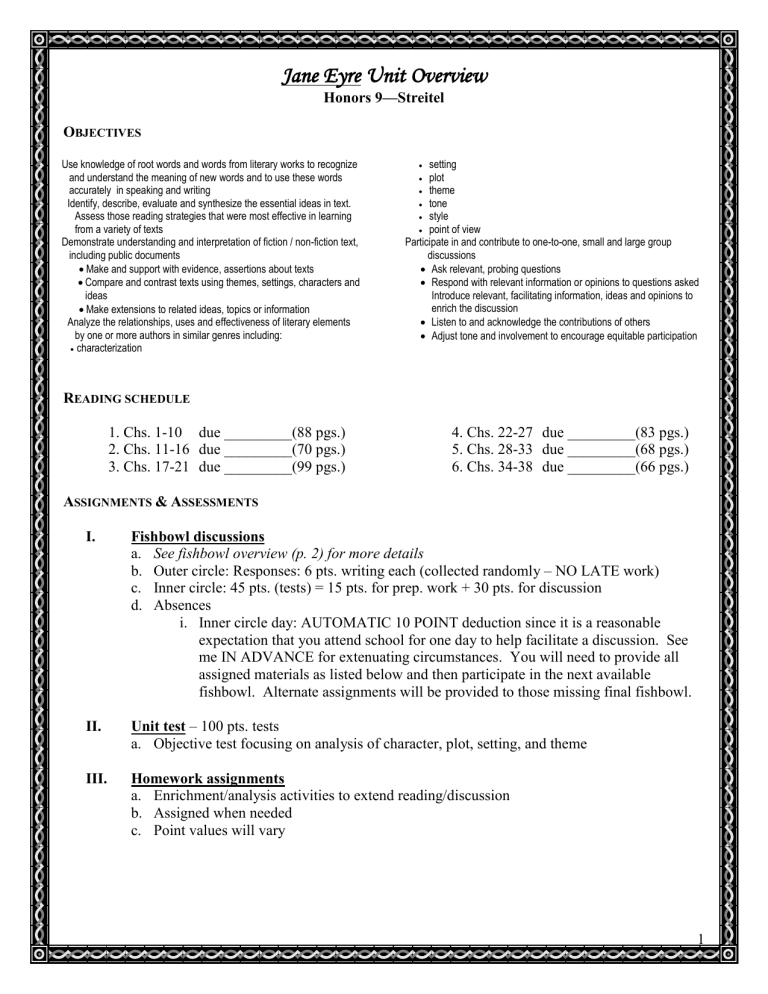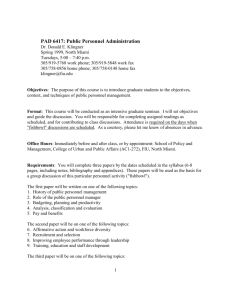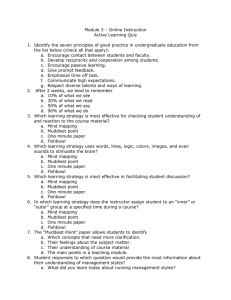Jane Eyre Unit Overview

Jane Eyre Unit Overview
Honors 9—Streitel
O BJECTIVES
Use knowledge of root words and words from literary works to recognize and understand the meaning of new words and to use these words accurately in speaking and writing
Identify, describe, evaluate and synthesize the essential ideas in text.
Assess those reading strategies that were most effective in learning from a variety of texts
Demonstrate understanding and interpretation of fiction / non-fiction text, including public documents
Make and support with evidence, assertions about texts
Compare and contrast texts using themes, settings, characters and ideas
Make extensions to related ideas, topics or information
Analyze the relationships, uses and effectiveness of literary elements
by one or more authors in similar genres including: characterization
setting plot theme tone
style point of view
Participate in and contribute to one-to-one, small and large group discussions
Ask relevant, probing questions
Respond with relevant information or opinions to questions asked
Introduce relevant, facilitating information, ideas and opinions to enrich the discussion
Listen to and acknowledge the contributions of others
Adjust tone and involvement to encourage equitable participation
R EADING SCHEDULE
1. Chs. 1-10 due _________(88 pgs.)
2. Chs. 11-16 due _________(70 pgs.)
3. Chs. 17-21 due _________(99 pgs.)
4. Chs. 22-27 due _________(83 pgs.)
5. Chs. 28-33 due _________(68 pgs.)
6. Chs. 34-38 due _________(66 pgs.)
A SSIGNMENTS & A SSESSMENTS
I.
Fishbowl discussions a.
See fishbowl overview (p. 2) for more details b.
Outer circle: Responses: 6 pts. writing each (collected randomly – NO LATE work) c.
Inner circle: 45 pts. (tests) = 15 pts. for prep. work + 30 pts. for discussion d.
Absences i.
Inner circle day: AUTOMATIC 10 POINT deduction since it is a reasonable expectation that you attend school for one day to help facilitate a discussion. See me IN ADVANCE for extenuating circumstances. You will need to provide all assigned materials as listed below and then participate in the next available fishbowl. Alternate assignments will be provided to those missing final fishbowl.
II.
Unit test – 100 pts. tests a.
Objective test focusing on analysis of character, plot, setting, and theme
III.
Homework assignments a.
Enrichment/analysis activities to extend reading/discussion b.
Assigned when needed c.
Point values will vary
1
F ISHBOWL O VERVIEW
Purpose : To foster analytical conversations about literature; to further collaboration skills; to encourage thoughtful sharing of ideas and acceptance of divergent views.
What is a fishbowl?
A fishbowl is a discussion during which a small group (the inner circle) prepares for and responds to a set of questions related to a shared reading. This small group is responsible for holding a discussion while the rest of the group (the outer circle) observes and makes notes about the discussion. At any time, a member of the outer circle may enter the inner discussion by sitting in the vacant chair in the inner circle.
Then, he/she may share an opinion, ask a question, or challenge a view. Once that person is finished, he or she returns to the outer circle. Other outer circle members may also join by tapping the initial outer circle student on the shoulder and then taking the “vacant” seat. The discussion continues for the specified time, after which the class debriefs. Outer circle members will provide feedback for the inner circle students.
What Do I Have to Do? (All submitted work needs to be TYPED)
Inner Circle Member (discussion) Outer Circle Member (audience)
Before the Fishbowl
1.
Prepare a Reading Process (no skeleton)
2.
Include 4+ open-ended questions that you can bring up to your group
3.
Respond to the discussion questions provided to you (include as #3 in After section)
4.
Hand in rubric (p. 3)
During the Fishbowl
5.
Actively participate in the discussion by raising salient points, asking questions, refuting positions, providing evidence, or supporting a point (45 minutes).
6.
Speak with respect for the other participants and for divergent views
7.
Support all points with evidence from the text
8.
Have AT LEAST FIVE exchanges with members of the circle ( exchanges are classified as any of the participation methods noted in #6)
After the Fishbowl
9.
Hand in your RP.
Before the Fishbowl
1.
Respond to the discussion questions.
Responses must be typed, proofread, and evidence-based . Provide specific quotations and page numbers for ALL responses.
During the Fishbowl
2.
You will be assigned to assess a member of the inner circle during the discussion—use the rubric provided to record information about your speaker’s participation and strengths/weaknesses
3.
You may participate in the discussion at any time by sitting in the vacant seat as described above.
After the Fishbowl
4.
Give your feedback sheet to the teacher, who will pass it along to your speaker.
5.
You may also ask questions or provide comments for the inner circle in general.
6.
Submit your question responses when requested. * (Responses are collected randomly and not accepted late.)
2
Jane Eyre Fishbowl GRADING Rubric
Student Name ______________________ Chs. ________________ _______/45
You contributed a new perspective on the topic to the discussion
You connected your opinion to the text - continual references which demonstrated close contextual analysis
You connected your opinion to another opinion expressed in the discussion, by describing to what degree you agree or disagree with it, and why.
You enriched the discussion by engaging other classmates in continued discussion.
0
No contribution or a “10second contribution” to the discussion
No contribution or a “10second contribution”
No contribution or a “10second contribution”
No contribution or a “10second contribution”
1
Your contributions were repetitive of what someone else had already said
Your contributions made no connection to the text
Your contributions made no connection to any other opinions offered during the discussion.
Your contributions were more like monologues - individual statements - rather than parts of a conversation or discussion among a group of classmates, so they didn’t lead into further discussion
2
Your contributions had elements of a new perspective on the topic, but didn’t explain it clearly enough
Your contributions offered a general reference to the text
Your contributions made some reference to other opinions expressed in the discussion
Your contributions showed effort to engage other classmates in continued discussion, even though they didn’t generate much response from other fishbowl participants
3
Your contributions provided a completely new perspective on the topic to the discussion, in a way that we all could understand, even if we didn’t agree
Your contributions clearly connected your opinion to specific passages in the text in a way that we could all understand, even if we didn’t agree
Your contributions were well-connected, either in agreement, disagreement, or a mix of both, to other opinions expressed during the discussion, and you clearly explained your reasons
Your contributions enriched the discussion by engaging other classmates in continued discussion, as evidenced by other fishbowl participants responding to your contributions.
TOTAL: ____ / 30
You interacted at least FIVE times .
You did not meet the interaction requirement
( automatic
50% deduction )
You met the interaction requirement.
Fishbowl preparation work (RP): _________ / 15
3
Jane Eyre Reading Process
Name ________________________
A.
R EADING P ROCESS
BEFORE R EADING
Chapters ___________________
1.
Author’s purpose:
2.
What I Already Know (WIAK) about the topic:
3.
What I predict about the reading:
4.
Questions to be answered (2+ and specific to this section):
DURING R EADING
What the author says (plot, setting, characters)
2+ / chapter
Main ideas
(not facts—what do these details indicate?)
2+ / chapter
What the author does (style, POV, tone)
2+ / chapter
(QUOTES and page numbers required here)
Chapter #
Analysis
(not facts—why might the author use these devices or stylistic choices?)
1 per item from column 3
Chapter #
What the author means (themes, morals—complete sentences, not single words)
3+
Chapter # Chapter #
AFTER R EADING
1.
Answer BEFORE questions (#4 above) if possible:
2.
Write down confusions you encountered (words, lines, actions, ideas, etc.) and questions you still have:
3.
Answer ALL assigned discussion questions with specific evidence for each item.
B.
Y OUR CREATED D ISCUSSION Q UESTIONS (4+)
C.
W ORKS C ITED (MLA FORMAT )
4





